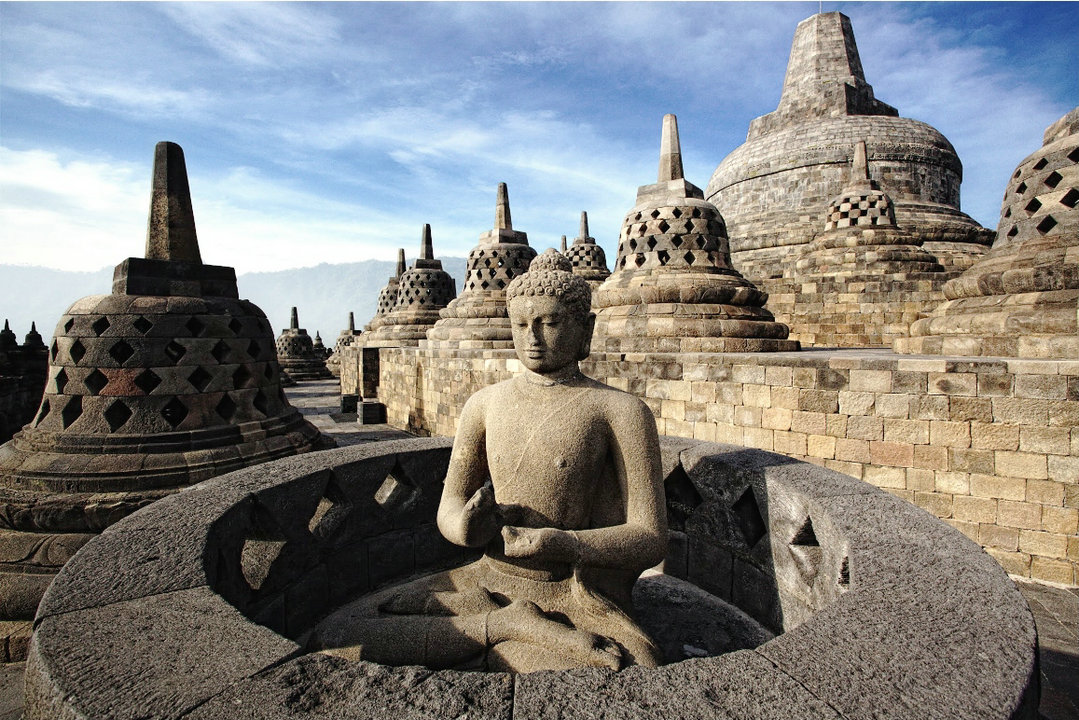PT.Taman Wisata Candi Borobudur, Prambanan & Ratu Boko [Persero] is the National Authority Agency responsible for the protection and conservation of the Borobudur Prambanan UNESCO World Culture Heritage and archaeological parks, the preservation of their histories and cultural heritage as well as the development and promotion of the UNESCO World Cultural Heritage sites as leading tourist destinations. The temples are indeed perfect examples of Indonesiaís richness in culture and diversity.
Candi Prambanan or Candi Rara Jonggrang is a 9th-century Hindu temple compound in Central Java, Indonesia, dedicated to the Trimurti, the expression of God as the Creator (Brahma), the Preserver (Vishnu) and the Destroyer (Shiva). The temple compound is located approximately 17 kilometres (11 mi) northeast of the city of Yogyakarta on the boundary between Central Java and Yogyakarta provinces.
The temple compound, a UNESCO World Heritage Site, is the largest Hindu temple site in Indonesia, and one of the biggest in Southeast Asia. It is characterized by its tall and pointed architecture, typical of Hindu architecture, and by the towering 47-metre-high (154 ft) central building inside a large complex of individual temples.Prambanan attracts many visitors from around the world.
Borobudur, or Barabudur (Indonesian: Candi Borobudur) is a 9th-century Mahayana Buddhist temple in Magelang, Central Java, Indonesia, as well as the world’s largest Buddhist temple, and also one of the greatest Buddhist monuments in the world. The temple consists of nine stacked platforms, six square and three circular, topped by a central dome. The temple is decorated with 2,672 relief panels and 504 Buddha statues. The central dome is surrounded by 72 Buddha statues, each seated inside a perforated stupa.
Built in the 9th century during the reign of the Sailendra Dynasty, the temple was designed in Javanese Buddhist architecture, which blends the Indonesian indigenous cult of ancestor worship and the Buddhist concept of attaining Nirvana. The temple also demonstrates the influences of Gupta art that reflects India’s influence on the region, yet there are enough indigenous scenes and elements incorporated to make Borobudur uniquely Indonesian. The monument is both a shrine to the Lord Buddha and a place for Buddhist pilgrimage. The journey for pilgrims begins at the base of the monument and follows a path around the monument and ascends to the top through three levels symbolic of Buddhist cosmology: Kāmadhātu (the world of desire), Rupadhatu (the world of forms) and Arupadhatu (the world of formlessness). The monument guides pilgrims through an extensive system of stairways and corridors with 1,460 narrative relief panels on the walls and the balustrades. Borobudur has the largest and most complete ensemble of Buddhist reliefs in the world.
Evidence suggests Borobudur was constructed in the 9th century and abandoned following the 14th-century decline of Hindu kingdoms in Java and the Javanese conversion to Islam. Worldwide knowledge of its existence was sparked in 1814 by Sir Thomas Stamford Raffles, then the British ruler of Java, who was advised of its location by native Indonesians. Borobudur has since been preserved through several restorations. The largest restoration project was undertaken between 1975 and 1982 by the Indonesian government and UNESCO, following which the monument was listed as a UNESCO World Heritage Site.
Borobudur is still used for pilgrimage; once a year, Buddhists in Indonesia celebrate Vesak at the monument, and Borobudur is Indonesia’s single most visited tourist attraction.
In Indonesian, ancient temples are referred to as candi; thus locals refer to “Borobudur Temple” as Candi Borobudur. The term candi also loosely describes ancient structures, for example gates and baths. The origins of the name Borobudur, however, are unclear,] although the original names of most ancient Indonesian temples are no longer known. The name Borobudur was first written in Sir Thomas Raffles’s book on Javan history. Raffles wrote about a monument called Borobudur, but there are no older documents suggesting the same name. The only old Javanese manuscript that hints the monument called Budur as a holy Buddhist sanctuary is Nagarakretagama, written by Mpu Prapanca, a Buddhist scholar of Majapahit court, in 1365.
